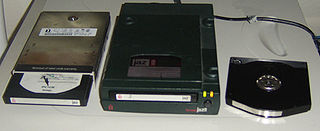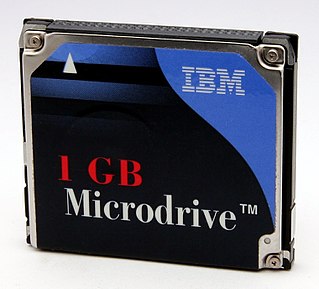
A hard disk drive (HDD), hard disk, hard drive, or fixed disk, is an electro-mechanical data storage device that stores and retrieves digital data using magnetic storage with one or more rigid rapidly rotating platters coated with magnetic material. The platters are paired with magnetic heads, usually arranged on a moving actuator arm, which read and write data to the platter surfaces. Data is accessed in a random-access manner, meaning that individual blocks of data can be stored and retrieved in any order. HDDs are a type of non-volatile storage, retaining stored data when powered off. Modern HDDs are typically in the form of a small rectangular box.
Maxtor was an American computer hard disk drive manufacturer. Founded in 1982, it was the third largest hard disk drive manufacturer in the world before being purchased by Seagate in 2006.

Western Digital Corporation is an American computer drive manufacturer and data storage company, headquartered in San Jose, California. It designs, manufactures and sells data technology products, including data storage devices, data center systems and cloud storage services.

The Power Macintosh G3 is a series of personal computers designed, manufactured, and sold by Apple Computer from November 1997 to August 1999. It represented Apple's first step towards eliminating redundancy and complexity in the product line by replacing eight Power Macintosh models with three: Desktop and Mini Tower models for professional and home use, and an All-In-One model for education. The introduction of the Desktop and Mini Tower models coincided with Apple starting to sell build-to-order Macs directly from its web site in an online store, which was unusual for the time as Dell was the only major computer manufacturer doing this. Apple's move to build-to-order sales of the Power Macintosh G3 also coincided with the acquisition of Power Computing Corporation, which had been providing telephone sales of Macintosh clones for more than two years.

The SGI Indigo2 and the SGI Challenge M are Unix workstations which were designed and sold by SGI from 1992 to 1997.

REV is a removable hard disk storage system from Iomega.

The Jaz drive is a removable hard disk storage system sold by the Iomega company from 1995 to 2002.

The Western Digital Raptor is a discontinued series of high performance hard disk drives produced by Western Digital first marketed in 2003. The drive occupies a niche in the enthusiast, workstation and small-server market. Traditionally, the majority of servers used hard drives featuring a SCSI interface because of their advantages in both performance and reliability over consumer-level ATA drives.

Cylinder-head-sector (CHS) is an early method for giving addresses to each physical block of data on a hard disk drive.

The Macintosh Quadra 950 is a personal computer designed, manufactured and sold by Apple Computer from March 1992 to October 1995. It replaced the Quadra 900 that was introduced several months earlier, increasing the CPU clock rate of its 68040 CPU from 25 MHz to 33 MHz, and improving the graphics support. The two computers were otherwise identical, including the price. With a Macintosh Processor Upgrade Card installed, this computer is known as the Power Macintosh 950.

The Microdrive is a type of miniature, 1-inch hard disks produced by IBM and Hitachi. These rotational media storage devices were designed to fit in CompactFlash (CF) Type II slots.
The Quantum Bigfoot brand was a series of hard disk drives produced by Quantum Corp. from 1996 through the late 1990s. The Bigfoot series was notable for deviating from the standard form factor for hard drives. While most desktop hard drives at that time used a 3.5-inch physical format, Quantum Bigfoot drives used a larger 5.25-inch form factor more commonly seen in older hard drives, CD-ROM and other optical disc drives. This form factor allowed Quantum to increase the capacity of their hard drives without an increase in data density, thus lowering costs compared to a 3.5-inch drive with the same capacity. It also allowed manufacturers and owners to install the hard drive above or below the optical drive in the computer, as the typical computer had multiple 5.25-inch bays.

Travelstar was a brand of 2.5-inch hard disk drive (HDD) that was introduced by IBM in 1994 with the announcement of the Travelstar LP. At 12.5 mm high with two platters, they were available in 360, 540 and 720 MB capacities. Initial models were industry-leading for small form factor HDDs in terms of areal density, data transfer rates and shock tolerance (500g).
In 1953, IBM recognized the immediate application for what it termed a "Random Access File" having high capacity and rapid random access at a relatively low cost. After considering technologies such as wire matrices, rod arrays, drums, drum arrays, etc., the engineers at IBM's San Jose California laboratory invented the hard disk drive. The disk drive created a new level in the computer data hierarchy, then termed Random Access Storage but today known as secondary storage, less expensive and slower than main memory but faster and more expensive than tape drives.

A solid-state drive (SSD) is a solid-state storage device that uses integrated circuit assemblies to store data persistently, typically using flash memory, and functioning as secondary storage in the hierarchy of computer storage. It is also sometimes called a semiconductor storage device, a solid-state device or a solid-state disk, even though SSDs lack the physical spinning disks and movable read–write heads used in hard disk drives (HDDs) and floppy disks. SSD also has rich internal parallelism for data processing.

In computer storage, disk buffer is the embedded memory in a hard disk drive (HDD) or solid state drive (SSD) acting as a buffer between the rest of the computer and the physical hard disk platter or flash memory that is used for storage. Modern hard disk drives come with 8 to 256 MiB of such memory, and solid-state drives come with up to 4 GB of cache memory.

The Power Macintosh 5500 is a personal computer designed, manufactured, and sold by Apple Computer from February 1997 to March 1998. Like the Power Macintosh 5260 and 5400 that preceded it, the 5500 is an all-in-one design, built around a PowerPC 603ev processor operating at 225, 250 or 275 megahertz (MHz).
Spin-up refers to the process of a hard disk drive or optical disc drive accelerating its platters or inserted optical disc from a stopped state to an operational speed. The required operational speed depends on the design of the disk drive. Typical speeds of hard disks have been 2400, 3600, 4200, 5400, 7200, 10000 and 15000 revolutions per minute (RPM). Achieving such speeds can require a significant portion of the available power budget of a computer system, and so application of power to the disks must be carefully controlled. Operational speed of optical disc drives may vary depending on type of disc and mode of operation.

The Seagate Barracuda is a series of hard disk drives and later solid state drives produced by Seagate Technology that was first introduced in 1993.
Higher performance in hard disk drives comes from devices which have better performance characteristics. These performance characteristics can be grouped into two categories: access time and data transfer time.
















